组织文化量表
- 格式:doc
- 大小:61.50 KB
- 文档页数:2
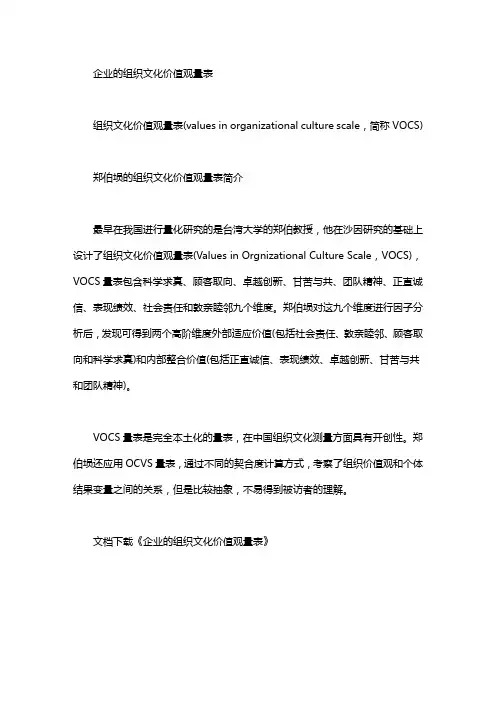
企业的组织文化价值观量表
组织文化价值观量表(values in organizational culture scale,简称VOCS)
郑伯埙的组织文化价值观量表简介
最早在我国进行量化研究的是台湾大学的郑伯教授,他在沙因研究的基础上设计了组织文化价值观量表(Values in Orgnizational Culture Scale,VOCS),VOCS量表包含科学求真、顾客取向、卓越创新、甘苦与共、团队精神、正直诚信、表现绩效、社会责任和敦亲睦邻九个维度。
郑伯埙对这九个维度进行因子分析后,发现可得到两个高阶维度外部适应价值(包括社会责任、敦亲睦邻、顾客取向和科学求真)和内部整合价值(包括正直诚信、表现绩效、卓越创新、甘苦与共和团队精神)。
VOCS量表是完全本土化的量表,在中国组织文化测量方面具有开创性。
郑伯埙还应用OCVS量表,通过不同的契合度计算方式,考察了组织价值观和个体结果变量之间的关系,但是比较抽象,不易得到被访者的理解。
文档下载《企业的组织文化价值观量表》。
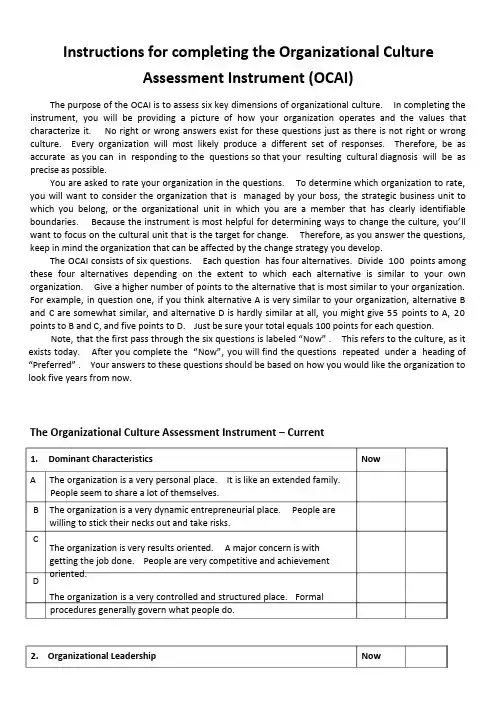
Instructions for completing the Organizational CultureAssessment Instrument (OCAI)The purpose of the OCAI is to assess six key dimensions of organizational culture. In completing the instrument, you will be providing a picture of how your organization operates and the values that characterize it. No right or wrong answers exist for these questions just as there is not right or wrong culture. Every organization will most likely produce a different set of responses. Therefore, be as accurate as you can in responding to the questions so that your resulting cultural diagnosis will be as precise as possible.You are asked to rate your organization in the questions. To determine which organization to rate, you will want to consider the organization that is managed by your boss, the strategic business unit to which you belong, or the organizational unit in which you are a member that has clearly identifiable boundaries. Because the instrument is most helpful for determining ways to change the culture, you ’ll want to focus on the cultural unit that is the target for change. Therefore, as you answer the questions, keep in mind the organization that can be affected by the change strategy you develop.The OCAI consists of six questions. Each question has four alternatives. Divide 100 points among these four alternatives depending on the extent to which each alternative is similar to your own organization. Give a higher number of points to the alternative that is most similar to your organization. For example, in question one, if you think alternative A is very similar to your organization, alternative B and C are somewhat similar, and alternative D is hardly similar at all, you might give 55 points to A, 20 points to B and C, and five points to D. Just be sure your total equals 100 points for each question.Note, that the first pass through the six questions is labeled “Now ” . This refers to the culture, as it exists today. After you complete the “Now ”, you will find the questions repeated under a heading of “Preferred ” . Your answers to these questions should be based on how you would like the organization to look five years from now.The Organizational Culture Assessment Instrument – Current2. Organizational Leadership NowDominant CharacteristicsThe organization is a very personal place. It is like an extended family. People seem to share a lot of themselves.The organization is a very dynamic entrepreneurial place. People are willing to stick their necks out and take risks.The organization is very results oriented. A major concern is with getting the job done. People are very competitive and achievement oriented.The organization is a very controlled and structured place. Formal procedures generally govern what people do.1. ABCDNowA The leadership in the organization is generally considered to exemplifymentoring, facilitating, or nurturing.B The leadership in the organization is generally considered to exemplifyentrepreneurship, innovating, or risk taking.C The leadership in the organization is generally considered to exemplify ano-nonsense, aggressive, results-oriented focus.D The leadership in the organization is generally considered to exemplifycoordinating, organizing, or smooth-running efficiency.Total3.Management of Employees NowA B C D The management style in the organization is characterized by teamwork, consensus, and participation.The management style in the organization is characterized by individual risk-taking, innovation, freedom, and uniqueness.The management style in the organization is characterized by hard-driving competitiveness, high demands, and achievement.The management style in the organization is characterized by security of employment, conformity, predictability, and stability in relationships. Total4. AB C Organization GlueThe glue that holds the organization together is loyalty and mutual trust. Commitment to this organization runs high.The glue that holds the organization together is commitment to innovation and development. There is an emphasis on being on the cutting edge.The glue that holds the organization together is the emphasis on achievement and goal accomplishment. Aggressiveness and winning are common themes.D The glue that holds the organization together is formal rules and policies.Maintaining a smooth-running organization is important.Total5.Strategic Emphases NowNowThe Organizational Culture Assessment Instrument – Preferred1. Dominant CharacteristicsA The organization is a very personal place. It is like an extendedfamily. People seem to share a lot of themselves. B The organization is a very dynamic entrepreneurial place. People arewilling to stick their necks out and take risks. C The organization is very results oriented. A major concern is withgetting the job done. People are very competitive and achievement oriented.D The organization is a very controlled and structured place. Formalprocedures generally govern what people do.TotalPreferred6. Criteria of SuccessNowAThe organization defines success on the basis of the development of human resources, teamwork, employee commitment, and concern for people.B The organization defines success on the basis of having the most unique ornewest products. It is a product leader and innovator.CThe organization defines success on the basis of winning in the marketplace and outpacing the competition. Competitive market leadership is key.DThe organization defines success on the basis of efficiency. Dependable delivery, smooth scheduling and low-cost production are critical.TotalThe organization emphasizes human development. High trust, openness, and participation persist.The organization emphasizes acquiring new resources and creating new challenges. Trying new things and prospecting for opportunities are valued.The organization emphasizes competitive actions and achievement. Hitting stretch targets and winning in the marketplace are dominant.The organization emphasizes permanence and stability. Efficiency, control and smooth operations are important.TotalA BCD2. A B C D3. A B C D4. A BC D5. A Organizational LeadershipThe leadership in the organization is generally considered to exemplifymentoring, facilitating, or nurturing.The leadership in the organization is generally considered to exemplify entrepreneurship, innovating, or risk taking.The leadership in the organization is generally considered to exemplifya no-nonsense, aggressive, results-oriented focus.The leadership in the organization is generally considered to exemplifycoordinating, organizing, or smooth-running efficiency.TotalManagement of EmployeesThe management style in the organization is characterized byteamwork, consensus, and participation.The management style in the organization is characterized byindividual risk-taking, innovation, freedom, and uniqueness.The management style in the organization is characterized byhard-driving competitiveness, high demands, and achievement.The management style in the organization is characterized by securityof employment, conformity, predictability, and stability inrelationships.TotalOrganization GlueThe glue that holds the organization together is loyalty and mutualtrust. Commitment to this organization runs high.The glue that holds the organization together is commitment toinnovation and development. There is an emphasis on being on thecutting edge.The glue that holds the organization together is the emphasis onachievement and goal accomplishment. Aggressiveness and winningare common themes.The glue that holds the organization together is formal rules andpolicies. Maintaining a smooth-running organization is important.TotalStrategic EmphasesThe organization emphasizes human development. High trust,openness, and participation persist.PreferredPreferredPreferredPreferredAn Example of How Culture Ratings Might AppearScoring:Scoring the OCAI is very easy. It requires simple arithmetic calculations. The first step is to add together all A responses in the Now column and divide by six. That is, computeNOWPREFERREDA 55 A 35B 20 B 30C 20 C 25 D5D10 Total100Total100The organization emphasizes acquiring new resources and creating new challenges. Trying new things and prospecting for opportunities are valued.The organization emphasizes competitive actions and achievement. Hitting stretch targets and winning in the marketplace are dominant.The organization emphasizes permanence and stability. Efficiency, control and smooth operations are important. TotalCriteria of SuccessThe organization defines success on the basis of the development of human resources, teamwork, employee commitment, and concern for people.The organization defines success on the basis of having the most unique or newest products. It is a product leader and innovator. The organization defines success on the basis of winning in the marketplace and outpacing the competition. Competitive market leadership is key.The organization defines success on the basis of efficiency. Dependable delivery, smooth scheduling and low-cost production are critical. TotalBCD6.ABCDPreferredan average score for the A alternatives in the Now column. You may use the worksheet on the next page to arrive at these averages. Do this for all of the questions, A, B, C, and D. Once you have done this, transfer your answers to this page in the boxes provided below.Fill in your answers here from the previous pagePREFERREDA BCDTotalNOWA BCDTotalA Worksheet for Scoring the OCAINOW Scores1A 1B2A 2B3A 3B4A 4B5A 5B6A 6BSum (total of A responses) Sum (total of B responses) Average(sum divided by6)Average(sum divided by6)1C 1D2C 2D3C 3D4C 4D5C 5D6C 6DSum (total of C responses) Sum (total of D responses) Average(sum divided by6)Average(sum divided by6)PREFERRED Scores1A 1B2A 2B3A 3B4A 4B5A 5B6A 6BSum (total of A responses) Sum (total of B responses) Average(sum divided by6)Average(sum divided by6)1C 2C 3C 4C 5C 1D 2D 3D 4D 5D6CSum (total of C responses) Average(sum divided by6)6DSum (total of D responses) Average(sum divided by6)组织文化量表(OCAI)的填写指导书组织文化量表的目的是评估企业文化的六个主要方面对企业产生的影响。

您好!我正进行一项学术研究:开发一套测量学生组织的组织文化的量表。
这也是我的本科毕业论文。
您的意见对我十分重要,非常期待您的帮助!
下面是一份现成的组织文化量表(Denison组织文化量表,简称OQC,是西方盛行的一个量表).烦请您阅读,并标注出不适合用于测量学生组织的部分.如有补充,您可另外加上。
我将根据您提供的意见,对此量表进行修订,再利用修订后量表,在某一学生组织进行调查.
如不耽误您的工作,烦请您尽可能在2009年2月28日(星期六)前发回给本人.再次感谢您的帮助!祝您工作顺利!
Denison组织文化量表(中文版)。
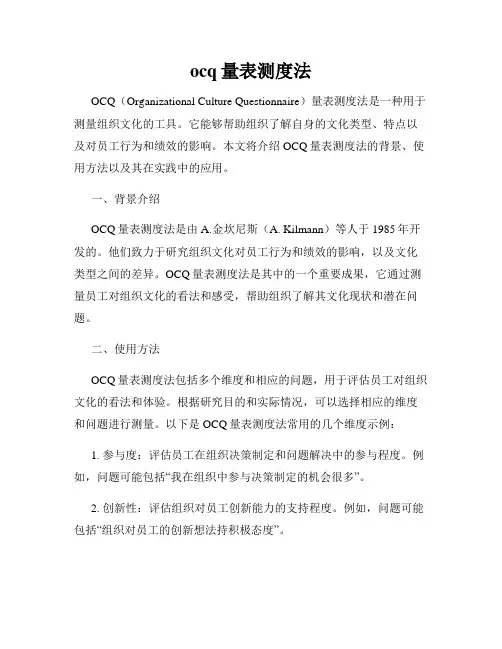
ocq量表测度法OCQ(Organizational Culture Questionnaire)量表测度法是一种用于测量组织文化的工具。
它能够帮助组织了解自身的文化类型、特点以及对员工行为和绩效的影响。
本文将介绍OCQ量表测度法的背景、使用方法以及其在实践中的应用。
一、背景介绍OCQ量表测度法是由A.金坎尼斯(A. Kilmann)等人于1985年开发的。
他们致力于研究组织文化对员工行为和绩效的影响,以及文化类型之间的差异。
OCQ量表测度法是其中的一个重要成果,它通过测量员工对组织文化的看法和感受,帮助组织了解其文化现状和潜在问题。
二、使用方法OCQ量表测度法包括多个维度和相应的问题,用于评估员工对组织文化的看法和体验。
根据研究目的和实际情况,可以选择相应的维度和问题进行测量。
以下是OCQ量表测度法常用的几个维度示例:1. 参与度:评估员工在组织决策制定和问题解决中的参与程度。
例如,问题可能包括“我在组织中参与决策制定的机会很多”。
2. 创新性:评估组织对员工创新能力的支持程度。
例如,问题可能包括“组织对员工的创新想法持积极态度”。
3. 控制度:评估组织对员工行为的控制程度。
例如,问题可能包括“组织对员工的行为有明确的规定和限制”。
4. 激励度:评估组织对员工绩效的奖励和激励程度。
例如,问题可能包括“组织对绩效突出的员工给予适当的奖励和认可”。
通过对以上维度进行测量,可以得出员工对组织文化的评价和看法。
根据不同维度的得分,可以分析出组织的文化类型以及潜在的问题和优势。
这些分析结果可以帮助组织制定相应的管理策略和文化改进计划。
三、实践应用OCQ量表测度法在实践中得到了广泛的应用。
以下是几个实际应用的例子:1. 组织文化评估:通过使用OCQ量表测度法,组织可以全面了解自身文化的特点和问题,为后续的文化改进和管理策略提供依据。
2. 文化差异研究:通过比较不同组织的OCQ测量结果,研究人员可以揭示不同文化类型之间的差异,进一步理解文化对员工行为和绩效的影响。

组织文化氛围评价量表引言:组织文化氛围是指组织内部所形成的一种价值观、行为规范和工作风格等共同的理念和信念。
一个良好的组织文化氛围可以促进员工的凝聚力、创造力和工作积极性,进而提高组织的绩效。
为了评估组织文化氛围,可以使用一份量表,通过各种维度的评价指标来了解组织文化氛围的现状和问题,从而有针对性地进行改进和提升。
一、领导力领导力是组织文化氛围的核心驱动力之一。
评价领导力可以从以下几个维度考虑:1. 领导者的激励能力:领导者是否能够激励员工充分发挥自己的潜力,提高工作效率和质量。
2. 领导者的沟通能力:领导者是否能够与员工保持良好的沟通,及时传递信息、解答问题,避免信息不畅通带来的误解和冲突。
3. 领导者的目标设定能力:领导者是否能够设定明确的目标,并将其有效传达给员工,从而使员工在工作中有明确的方向和目标。
二、团队合作团队合作是组织文化氛围中的重要组成部分。
评价团队合作可以从以下几个维度考虑:1. 团队的协作能力:团队成员是否能够相互协作,共同完成任务,避免个人主义行为对整个团队的负面影响。
2. 团队的信任度:团队成员之间是否存在足够的信任,能够坦诚相待,相互支持,共同面对困难和挑战。
3. 团队的冲突处理能力:团队成员是否能够有效处理冲突,以建设性的方式解决问题,避免冲突升级和团队氛围的恶化。
三、员工发展员工发展是组织文化氛围中的关键要素之一。
评价员工发展可以从以下几个维度考虑:1. 组织的培训机制:组织是否提供良好的培训机制,帮助员工提升自己的技能和知识,以适应工作的需要。
2. 组织的晋升机制:组织是否建立了公平、透明的晋升机制,为员工提供晋升的机会和发展空间。
3. 组织的反馈机制:组织是否提供及时、准确的反馈,帮助员工了解自己的优势和不足,进而做出相应的调整和改进。
四、创新与变革创新与变革是组织文化氛围中的推动力之一。
评价创新与变革可以从以下几个维度考虑:1. 组织的创新氛围:组织是否鼓励员工提出新的想法和建议,为员工提供创新的环境和资源。
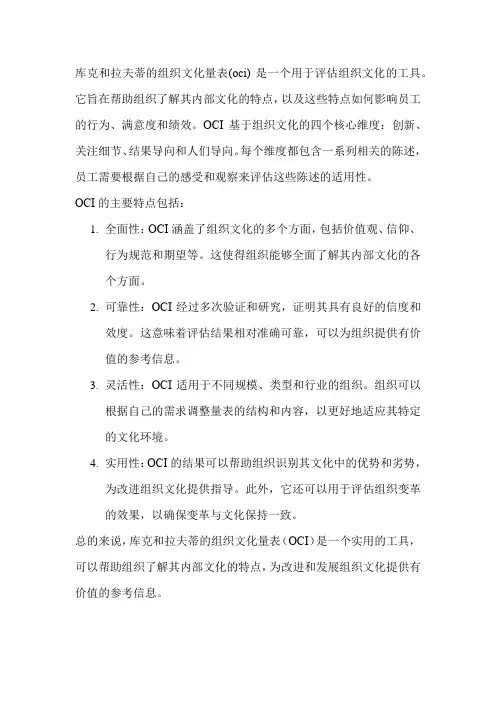
库克和拉夫蒂的组织文化量表(oci)是一个用于评估组织文化的工具。
它旨在帮助组织了解其内部文化的特点,以及这些特点如何影响员工的行为、满意度和绩效。
OCI基于组织文化的四个核心维度:创新、关注细节、结果导向和人们导向。
每个维度都包含一系列相关的陈述,员工需要根据自己的感受和观察来评估这些陈述的适用性。
OCI的主要特点包括:
1.全面性:OCI涵盖了组织文化的多个方面,包括价值观、信仰、
行为规范和期望等。
这使得组织能够全面了解其内部文化的各
个方面。
2.可靠性:OCI经过多次验证和研究,证明其具有良好的信度和
效度。
这意味着评估结果相对准确可靠,可以为组织提供有价
值的参考信息。
3.灵活性:OCI适用于不同规模、类型和行业的组织。
组织可以
根据自己的需求调整量表的结构和内容,以更好地适应其特定
的文化环境。
4.实用性:OCI的结果可以帮助组织识别其文化中的优势和劣势,
为改进组织文化提供指导。
此外,它还可以用于评估组织变革
的效果,以确保变革与文化保持一致。
总的来说,库克和拉夫蒂的组织文化量表(OCI)是一个实用的工具,可以帮助组织了解其内部文化的特点,为改进和发展组织文化提供有价值的参考信息。
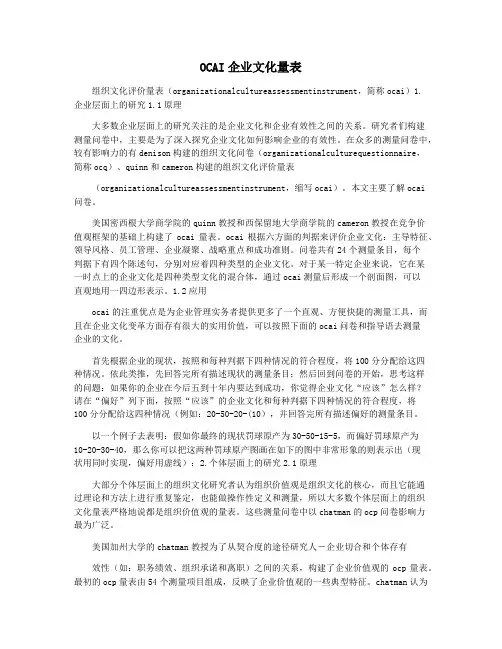
OCAI企业文化量表组织文化评价量表(organizationalcultureassessmentinstrument,简称ocai)1.企业层面上的研究1.1原理大多数企业层面上的研究关注的是企业文化和企业有效性之间的关系。
研究者们构建测量问卷中,主要是为了深入探究企业文化如何影响企业的有效性。
在众多的测量问卷中,较有影响力的有denison构建的组织文化问卷(organizationalculturequestionnaire,简称ocq)、quinn和cameron构建的组织文化评价量表(organizationalcultureassessmentinstrument,缩写ocai)。
本文主要了解ocai问卷。
美国密西根大学商学院的quinn教授和西保留地大学商学院的cameron教授在竞争价值观框架的基础上构建了ocai量表。
ocai根据六方面的判据来评价企业文化:主导特征、领导风格、员工管理、企业凝聚、战略重点和成功准则。
问卷共有24个测量条目,每个判据下有四个陈述句,分别对应着四种类型的企业文化。
对于某一特定企业来说,它在某一时点上的企业文化是四种类型文化的混合体,通过ocai测量后形成一个剖面图,可以直观地用一四边形表示。
1.2应用ocai的注重优点是为企业管理实务者提供更多了一个直观、方便快捷的测量工具,而且在企业文化变革方面存有很大的实用价值,可以按照下面的ocai问卷和指导语去测量企业的文化。
首先根据企业的现状,按照和每种判据下四种情况的符合程度,将100分分配给这四种情况。
依此类推,先回答完所有描述现状的测量条目;然后回到问卷的开始,思考这样的问题:如果你的企业在今后五到十年内要达到成功,你觉得企业文化“应该”怎么样?请在“偏好”列下面,按照“应该”的企业文化和每种判据下四种情况的符合程度,将100分分配给这四种情况(例如:20-50-20-(10),并回答完所有描述偏好的测量条目。
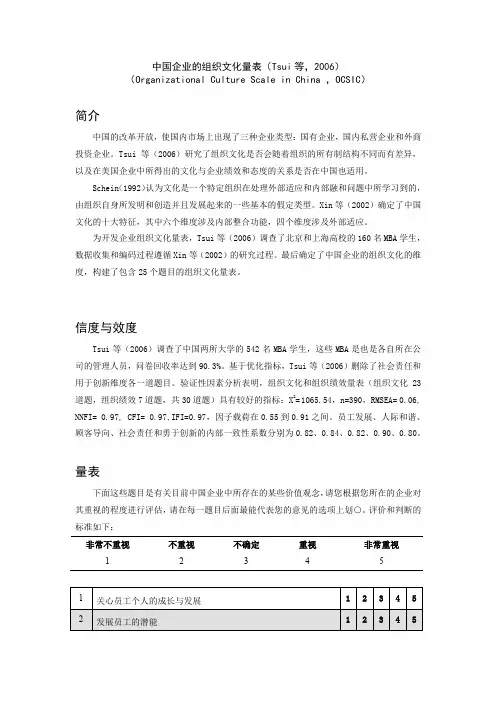
中国企业的组织文化量表(Tsui等,2006)(Organizational Culture Scale in China ,OCSIC)简介中国的改革开放,使国内市场上出现了三种企业类型:国有企业,国内私营企业和外商投资企业。
Tsui等(2006)研究了组织文化是否会随着组织的所有制结构不同而有差异,以及在美国企业中所得出的文化与企业绩效和态度的关系是否在中国也适用。
Schein(1992)认为文化是一个特定组织在处理外部适应和内部融和问题中所学习到的,由组织自身所发明和创造并且发展起来的一些基本的假定类型。
Xin等(2002)确定了中国文化的十大特征,其中六个维度涉及内部整合功能,四个维度涉及外部适应。
为开发企业组织文化量表,Tsui等(2006)调查了北京和上海高校的160名MBA学生,数据收集和编码过程遵循Xin等(2002)的研究过程。
最后确定了中国企业的组织文化的维度,构建了包含25个题目的组织文化量表。
信度与效度Tsui等(2006)调查了中国两所大学的542名MBA学生,这些MBA是也是各自所在公司的管理人员,问卷回收率达到90.3%。
基于优化指标,Tsui等(2006)删除了社会责任和用于创新维度各一道题目。
验证性因素分析表明,组织文化和组织绩效量表(组织文化23道题,组织绩效7道题,共30道题)具有较好的指标:X2=1065.54,n=390,RMSEA= 0.06, NNFI= 0.97, CFI= 0.97,IFI=0.97,因子载荷在0.55到0.91之间。
员工发展、人际和谐、顾客导向、社会责任和勇于创新的内部一致性系数分别为0.82、0.84、0.82、0.90、0.80。
量表下面这些题目是有关目前中国企业中所存在的某些价值观念,请您根据您所在的企业对其重视的程度进行评估,请在每一题目后面最能代表您的意见的选项上划○。
评价和判断的标准如下:非常不重视不重视不确定重视非常重视1 2 3 4 5计分方法中国企业的组织文化量表包括员工发展、人际和谐、顾客导向、社会责任和勇于创新五个分量表,共23道题,可以计算各个量表所包含题目的平均分或总分。

组织文化量表(Organizational Culture Assessment Instrument,简称OCAI),Cameron和Quinn(1998)提出的组织文化量表是以竞值架构理论为基础( Competing Values Framework,简称CVF),而组织文化的好坏更会进一步的影响组织的效能,其与决策的制定及人资管理更是密不可分的。
Cameron和Quinn将组织文化分为四种类型,包含:团队文化类型、灵活文化类型、市场文化类型和层级文化类型,量表分为六个维度,分别为主导特征、领导风格、员工管理、组织凝聚、战略重点和成功标准,总共为24个条目。
量表的计分方式将受试者感受、反应及认同程度为评定指标,采用五点量表级分方法。
其标准为“1”表示非常不符合;“2”表示不符合;“3”表示普通;“4”表示符合;“5”表示非常符合。
量表的条目一、主导特征1. 我的组织是一个人性化的组织,像一个大家庭,成员间能分享彼此的经验或想法①非常不符合②不符合③普通④符合⑤非常符合2. 我的组织是一个具有活力和创业精神的组织,成员富有进取心与冒险精神①非常不符合②不符合③普通④符合⑤非常符合3. 我的组织是成果导向型组织,强调工作的完成,成员具有强烈的竞争意识与成就导向①非常不符合②不符合③普通④符合⑤非常符合4. 我的组织是一个严格管理与层级分明的组织,成员严格按规章制度做事①非常不符合②不符合③普通④符合⑤非常符合二、领导风格5. 我的组织的最高管理者能主动指导、协助并关爱组织成员①非常不符合②不符合③普通④符合⑤非常符合6. 我的组织的最高管理者具有企业家精神,注重创新并勇于冒险①非常不符合②不符合③普通④符合⑤非常符合7. 我的组织的最高管理者行事严谨,富有进取心并重视成果①非常不符合②不符合③普通④符合⑤非常符合8. 我的组织的最高管理者擅于协调与组织,注重组织的顺畅运作①非常不符合②不符合③普通④符合⑤非常符合三、员工管理9. 我的组织重视团队合作、协商及成员的参与①非常不符合②不符合③普通④符合⑤非常符合10. 我的组织重视个人的冒险,强调创新、自由及展现自我①非常不符合②不符合③普通④符合⑤非常符合11. 我的组织强调竞争,强调高要求,注重竞争目标的达成①非常不符合②不符合③普通④符合⑤非常符合12. 我的组织重视成员工作的保障及稳定性,员工之间的关系是可预见及稳定的①非常不符合②不符合③普通④符合⑤非常符合四、组织凝聚13. 促使我的组织凝聚的力量是成员的忠诚及相互信任,强调对组织的承诺①非常不符合②不符合③普通④符合⑤非常符合14. 促使我的组织凝聚的力量是对创新与发展的承诺,强调走在时代的前沿①非常不符合②不符合③普通④符合⑤非常符合15. 促使我的组织凝聚的力量是对成就与目标达成的重视①非常不符合②不符合③普通④符合⑤非常符合16. 促使我的组织凝聚的力量是正式的规章制度,强调组织运作的顺畅①非常不符合②不符合③普通④符合⑤非常符合五、战略重点17. 我的组织重视人力资源的发展,强调高度信任、开诚布公及员工的持续参与①非常不符合②不符合③普通④符合⑤非常符合18. 我的组织重视获取新资源及迎接新挑战,强调尝试新事物和寻求新机遇①非常不符合②不符合③普通④符合⑤非常符合19. 我的组织重视竞争与成功,强调达成更多目标以及在市场中获胜①非常不符合②不符合③普通④符合⑤非常符合20. 我的组织重视持久与稳定,强调效率、控制及顺畅的运作①非常不符合②不符合③普通④符合⑤非常符合六、成功标准21. 我的组织对成功的界定是在人力资源、团队合作、员工承诺及关心员工方面得以发展①非常不符合②不符合③普通④符合⑤非常符合22. 我的组织对成功的界定是组织有独特、新颖的产品,是产品的领导者和创新者①非常不符合②不符合③普通④符合⑤非常符合23. 我的组织对成功的界定是赢得市场份额并且打败对手,成为市场的领导者①非常不符合②不符合③普通④符合⑤非常符合24. 我的组织对成功的界定是富有效率。
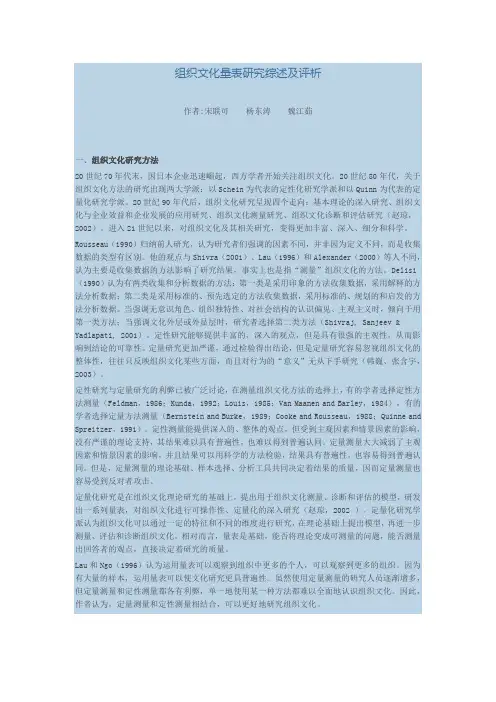
组织文化量表研究综述及评析作者:宋联可杨东涛魏江茹一、组织文化研究方法20世纪70年代末,因日本企业迅速崛起,西方学者开始关注组织文化。
20世纪80年代,关于组织文化方法的研究出现两大学派:以Schein为代表的定性化研究学派和以Quinn为代表的定量化研究学派。
20世纪90年代后,组织文化研究呈现四个走向:基本理论的深入研究、组织文化与企业效益和企业发展的应用研究、组织文化测量研究、组织文化诊断和评估研究(赵琼,2002)。
进入21世纪以来,对组织文化及其相关研究,变得更加丰富、深入、细分和科学。
Rousseau(1990)归纳前人研究,认为研究者们强调的因素不同,并非因为定义不同,而是收集数据的类型有区别。
他的观点与Shivra(2001)、Lau(1996)和Alexander(2000)等人不同,认为主要是收集数据的方法影响了研究结果,事实上也是指“测量”组织文化的方法。
Delisi (1990)认为有两类收集和分析数据的方法:第一类是采用印象的方法收集数据,采用解释的方法分析数据;第二类是采用标准的、预先选定的方法收集数据,采用标准的、规划的和启发的方法分析数据。
当强调无意识角色、组织独特性、对社会结构的认识偏见、主观主义时,倾向于用第一类方法;当强调文化外层或外显层时,研究者选择第二类方法(Shivraj, Sanjeev & Yadlapati, 2001)。
定性研究能够提供丰富的、深入的观点,但是具有很强的主观性,从而影响到结论的可靠性。
定量研究更加严谨,通过检验得出结论,但是定量研究容易忽视组织文化的整体性,往往只反映组织文化某些方面,而且对行为的“意义”无从下手研究(韩巍、张含宇,2003)。
定性研究与定量研究的利弊已被广泛讨论,在测量组织文化方法的选择上,有的学者选择定性方法测量(Feldman,1986;Kunda,1992;Louis,1985;Van Maanen and Barley,1984),有的学者选择定量方法测量(Bernstein and Burke,1989;Cooke and Rousseau,1988;Quinne and Spreitzer,1991)。
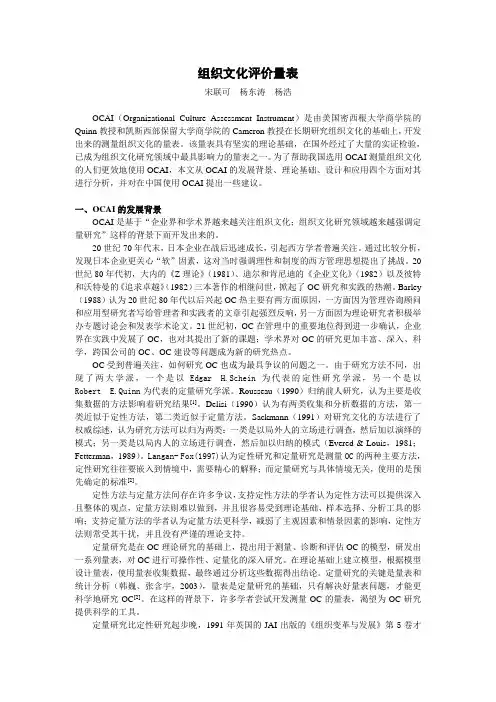
组织文化评价量表宋联可杨东涛杨浩OCAI(Organizational Culture Assessment Instrument)是由美国密西根大学商学院的Quinn教授和凯斯西部保留大学商学院的Cameron教授在长期研究组织文化的基础上,开发出来的测量组织文化的量表。
该量表具有坚实的理论基础,在国外经过了大量的实证检验,已成为组织文化研究领域中最具影响力的量表之一。
为了帮助我国选用OCAI测量组织文化的人们更效地使用OCAI,本文从OCAI的发展背景、理论基础、设计和应用四个方面对其进行分析,并对在中国使用OCAI提出一些建议。
一、OCAI的发展背景OCAI是基于“企业界和学术界越来越关注组织文化;组织文化研究领域越来越强调定量研究”这样的背景下而开发出来的。
20世纪70年代末,日本企业在战后迅速成长,引起西方学者普遍关注。
通过比较分析,发现日本企业更关心“软”因素,这对当时强调理性和制度的西方管理思想提出了挑战。
20世纪80年代初,大内的《Z理论》(1981)、迪尔和肯尼迪的《企业文化》(1982)以及彼特和沃特曼的《追求卓越》(1982)三本著作的相继问世,掀起了OC研究和实践的热潮。
Barley (1988)认为20世纪80年代以后兴起OC热主要有两方面原因,一方面因为管理咨询顾问和应用型研究者写给管理者和实践者的文章引起强烈反响,另一方面因为理论研究者积极举办专题讨论会和发表学术论文。
21世纪初,OC在管理中的重要地位得到进一步确认,企业界在实践中发展了OC,也对其提出了新的课题;学术界对OC的研究更加丰富、深入、科学,跨国公司的OC、OC建设等问题成为新的研究热点。
OC受到普遍关注,如何研究OC也成为最具争议的问题之一。
由于研究方法不同,出现了两大学派,一个是以Edgar H.Schein为代表的定性研究学派,另一个是以Robert E.Quinn为代表的定量研究学派。
Rousseau(1990)归纳前人研究,认为主要是收集数据的方法影响着研究结果[1]。
OCAI企业文化量表 组织文化评价量表(Organizational Culture Assessment Instrument,简称OCAI) 1. 企业层面上的研究 1.1 原理 大多数企业层面上的研究关注的是企业文化和企业有效性之间的关系。
研究者们构建测量问卷中,主要是为了深入探究企业文化如何影响企业的有效性。
在众多的测量问卷中,较有影响力的有Denison构建的组织文化问卷(Organizational Culture Questionnaire,简称OCQ)、Quinn和Cameron构建的组织文化评价量表(Organizational Culture Assessment Instrument,简称OCAI)。
本文主要介绍OCAI问卷。
美国密西根大学商学院的Quinn教授和西保留地大学商学院的Cameron教授在竞争价值观框架的基础上构建了OCAI量表。
OCAI根据六方面的判据来评价企业文化:主导特征、领导风格、员工管理、企业凝聚、战略重点和成功准则。
问卷共有24个测量条目,每个判据下有四个陈述句,分别对应着四种类型的企业文化。
对于某一特定企业来说,它在某一时点上的企业文化是四种类型文化的混合体,通过OCAI 测量后形成一个剖面图,可以直观地用一四边形表示。
1.2 应用 OCAI的突出优点在于为企业管理实务者提供了一个直观、便捷的测量工具,而且在企业文化变革方面有较大的实用价值,可以按照下面的OCAI问卷和指导语来测量企业的文化。
首先根据企业的现状,按照和每种判据下四种情况的符合程度,将100分分配给这四种情况。
依此类推,先回答完所有描述现状的测量条目;然后回到问卷的开始,思考这样的问题:如果你的企业在今后五到十年内要达到成功,你觉得企业文化“应该”怎么样?请在“偏好”列下面,按照“应该”的企业文化和每种判据下四种情况的符合程度,将100分分配给这四种情况(例如:20-50-20- (10),并回答完所有描述偏好的测量条目。
分析企业文化经典工具--OCS量表
作者:宋联可
Glaser、Zamanou和Hacker (1987)开发了组织文化测量量表(Organizational Culture Survey,OCS),该量表是标准的测量量表,在调查过程中,可以与其它测量技术结合,如关键事件访谈、编码访谈等。
OCS量表主要测量组织文化的六个组成部分:合作——冲突(teamwork-conflict)、氛围——士气(climate-morale)、信息流(information flow)、包含(involvement)、监督(supervision)和会议(meetings)。
OCS量表有62个题项,分为5个子量表:氛围、包含、沟通、监督和会议。
开始时要求员工描述在组织中的工作是什么样的,并鼓励通过故事来解释他们的感受。
然后将问卷发给所有成员,并在规定的地点和规定的时间填写完,从而消除回收率低的问题和取样错误,增加量表的有效性。
五个子量表的每个题项都是符合中间可靠性和中间一致性分析的要求。
修订后的量表只有31个题项,因为如果题项可由其它子量表中的题项预测出时就将其删除。
为了评价OCS量表的可靠性,完整的工具还包括35到52个题项。
这些题项提供回答者生日和他们母亲的婚前姓氏,这样可以把测试与再测试中的匿名问卷对照起来。
Falcone认为,可以运用此量表来帮助组织建立特定时期的组织文化,还可以发现一些组织存在的问题。
但是此量表有个最大的缺点,不能通过单独使用而获益。
因此,与其它方法共同使用才能使此量表更有效。
ocai likert量表OCAI Likert 量表:了解组织文化的框架组织文化影响着组织的各个方面,从员工行为到决策制定。
OCAI Likert 量表是一种广泛使用的工具,用于评估组织文化,它可以帮助组织了解自己的文化,并确定改进的领域。
OCAI Likert 量表的组成OCAI Likert 量表由 104 个条目组成,这些条目被分成以下四个维度:内部-外部重点:组织是专注于内部还是外部环境。
灵活性-稳定性:组织是灵活且适应性强的,还是稳定且结构化的。
人际-任务重点:组织更注重人际关系还是任务完成。
等级-集体主义:组织的权力结构是等级制的还是集体主义的。
使用 OCAI Likert 量表要使用 OCAI Likert 量表,组织需要将其分发给员工。
员工根据他们对组织文化的看法回答量表上的每个条目。
量表使用五分制李克特量表,其中 1 表示强烈不同意,5 表示强烈同意。
评分 OCAI Likert 量表OCAI 量表上的条目分为四个维度。
每个维度的平均得分为该维度的组织文化分数。
解释 OCAI Likert 量表的结果OCAI Likert 量表的结果可以帮助组织了解其文化在四个维度上的位置。
这可以帮助识别组织文化的优势和劣势。
组织文化类型OCAI Likert 量表的结果可以用来确定组织的文化类型。
这些类型包括:层次文化:内部重点、稳定性、任务重点、等级制。
宗族文化:内部重点、灵活性、人际关系重点、集体主义。
市场文化:外部重点、灵活性、任务重点、等级制。
适应文化:外部重点、稳定性、人际关系重点、集体主义。
使用 OCAI Likert 量表改善组织文化OCAI Likert 量表可以帮助组织确定需要改进的文化领域。
通过识别弱点并制定改善计划,组织可以创建一个更有效的文化,支持其战略目标。
OCAI Likert 量表的局限性尽管 OCAI Likert 量表是一个有价值的工具,但它也有一些局限性:量表可能很长且耗时。
库克和拉夫蒂的组织文化量表(oci)
库克和拉夫蒂的组织文化量表(OCI)是一种用于测量组织文化的工具。
该量表以“规范性信念”和“共同行为期望”为核心概念,分为十二个维度,包括人性鼓励、亲密关怀、认同接纳、传统保守、凡事依赖、回避推诿、对立抗衡、权力控制、强调竞争、完美主义、成就导向及自我实现等。
OCI量表可以用在任何组织框架中,并有多种用途,如识别什么地方需要变革、进一步观察文化变革、评价企业文化变革的结果、管理差异和跨国关系。
它几乎可以适用于所有组织。
此外,Cooke和Szumal以OCI的十二个维度为基础,提出了价值观层次
的三大导向,分别是关心人员/安全文化(people/security culture)、满
足需求文化(satisfaction culture)以及关心工作/安全文化
(task/security culture)三大部分。
以上内容仅供参考,如需更多信息,建议查阅OCI量表相关论文或咨询专
业人士。
组织文化评价量表组织文化评价量表组织文化评价量表宋联可杨东涛杨浩OCAI(Organizational Culture Assessment Instrument)是由美国密西根大学商学院的Quinn教授和凯斯西部保留大学商学院的Cameron教授在长期研究组织文化的基础上,开发出来的测量组织文化的量表。
该量表具有坚实的理论基础,在国外经过了大量的实证检验,已成为组织文化研究领域中最具影响力的量表之一。
为了帮助我国选用OCAI测量组织文化的人们更效地使用OCAI,本文从OCAI的发展背景、理论基础、设计和应用四个方面对其进行分析,并对在中国使用OCAI提出一些建议。
一、OCAI的发展背景OCAI是基于“企业界和学术界越来越关注组织文化;组织文化研究领域越来越强调定量研究”这样的背景下而开发出来的。
20世纪70年代末,日本企业在战后迅速成长,引起西方学者普遍关注。
通过比较分析,发现日本企业更关心“软”因素,这对当时强调理性和制度的西方管理思想提出了挑战。
20世纪80年代初,大内的《Z理论》(1981)、迪尔和肯尼迪的《企业文化》(1982)以及彼特和沃特曼的《追求卓越》(1982)三本著作的相继问世,掀起了OC研究和实践的热潮。
Barley(1988)认为20世纪80年代以后兴起OC热主要有两方面原因,一方面因为管理咨询顾问和应用型研究者写给管理者和实践者的文章引起强烈反响,另一方面因为理论研究者积极举办专题讨论会和发表学术论文。
21世纪初,OC在管理中的重要地位得到进一步确认,企业界在实践中发展了OC,也对其提出了新的课题;学术界对OC的研究更加丰富、深入、科学,跨国公司的OC、OC建设等问题成为新的研究热点。
OC受到普遍关注,如何研究OC也成为最具争议的问题之一。
由于研究方法不同,出现了两大学派,一个是以Edgar H.Schein为代表的定性研究学派,另一个是以Robert E.Quinn为代表的定量研究学派。
Volume 2 Issue 3
Organizational culture in the People’s Republic of China:
An Analysis of culture dimensions and culture types
中国企业的组织文化:维度与类型的分析
Anne S. Tsui (徐淑英) Hui Wang (王辉), Katherine R. Xin (忻榕)
下面这些题目是有关目前中国企业中所存在的某些价值观念,请您根据您所在的企业对其重视的程度进行评估,请在每一题目后面最能代表您的意见的选项上划圈。
1 23 4 5
非常不重视不重视不确定重视非常重视
您所在的企业非
常
不
重
视
不
重
视
不
确
定
重
视
非
常
重
视
员工发展(α=.82)
关心员工个人的成长与发展 1 2 3 4 5 发展员工的潜能 1 2 3 4 5 理解,信任员工 1 2 3 4 5 重视员工的建议 1 2 3 4 5 提供知识及技能的培训机会 1 2 3 4 5 人际和谐(α=.84)
重视团队建设 1 2 3 4 5 鼓励合作精神 1 2 3 4 5 促进员工之间情感的交流 1 2 3 4 5 鼓励员工之间的相互协作 1 2 3 4 5 员工之间相互体贴 1 2 3 4 5 顾客导向(α=.82)
最大限度满足顾客的需要 1 2 3 4 5 客户的利益高于一切 1 2 3 4 5 提倡顾客就是上帝 1 2 3 4 5 向顾客提供一流的服务 1 2 3 4 5 真诚服务客户 1 2 3 4 5 社会责任(α=.90)
重视社会责任 1 2 3 4 5 企业的使命就是服务社会 1 2 3 4 5 经济效益与社会效益并重 1 2 3 4 5 重视社会的长远发展 1 2 3 4 5 勇于创新(α=.80)
乐于接受新生事物 1 2 3 4 5 注重新产品,新服务的开发 1 2 3 4 5 鼓励创新 1 2 3 4 5 大胆引进高新科技 1 2 3 4 5。